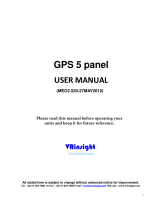
190-00498-07 Rev. A
Garmin G1000 Pilot’s Guide for Cessna Nav III
ix
TABLE OF CONTENTS
6.9 Traffic Information Service (TIS) ........................ 394
Displaying TRAFFIC Data ........................................... 395
Traffic Map Page ....................................................... 397
TIS Alerts ................................................................. 398
System Status ........................................................... 399
6.10 Garmin GTS 800 Traffic ....................................... 402
Theory of operation .................................................. 402
TAS Alerts ................................................................ 405
System Test .............................................................. 406
Operation ................................................................ 407
6.11 Honeywell KTA870 Traffic ................................... 415
TAS Symbology ......................................................... 415
Operation ................................................................ 416
Altitude Display ........................................................ 419
Traffic Map Page Display Range ................................. 419
TAS Alerts ................................................................ 421
System Status ........................................................... 422
6.12 ADS-B Traffic ........................................................ 423
SECTION 7 AUTOMATIC FLIGHT CONTROL SYSTEM
7.1 AFCS Controls ...................................................... 430
7.2 Flight Director Operation ................................... 432
Activating the Flight Director ..................................... 432
AFCS Status Box ....................................................... 433
Command Bars ......................................................... 434
Flight Director Modes ................................................ 434
7.3 Vertical Modes ..................................................... 435
Pitch Hold Mode (PIT) ............................................... 436
Selected Altitude Capture Mode (ALTS) ....................... 437
Altitude Hold Mode (ALT) .......................................... 438
Vertical Speed Mode (VS) .......................................... 439
Flight Level Change Mode (FLC) ................................. 440
Vertical Navigation Modes (VPTH, ALTV) ..................... 442
Glidepath Mode (GP) (SBAS Only) .............................. 447
Glideslope Mode (GS) ............................................... 449
Go Around Mode (GA) .............................................. 450
7.4 Lateral Modes ...................................................... 451
Roll Hold Mode (ROL) ............................................... 452
Heading Select Mode (HDG) ...................................... 453
Navigation Modes (GPS, VOR, LOC) ............................ 454
Approach Modes (GPS, VAPP, LOC) ............................. 456
Backcourse Mode (BC) .............................................. 458
7.5 Autopilot Operation ............................................ 459
Engaging the Autopilot ............................................. 459
Control Wheel Steering ............................................. 460
Disengaging the Autopilot ......................................... 460
7.6 Example Procedures ............................................461
Departure ................................................................ 462
Intercepting a VOR Radial .......................................... 464
Flying a Flight Plan/GPS Course ................................. 465
Descent ................................................................... 466
Approach ................................................................. 470
Go Around/Missed Approach ..................................... 474
7.7 AFCS Annunciations and Alerts ......................... 476
AFCS Status Alerts .................................................... 476
Overspeed Protection ................................................ 477
SECTION 8 ADDITIONAL FEATURES
8.1 Synthetic Vision System (SVS) (Optional) ......... 480
SVS Operation .......................................................... 481
SVS Features ............................................................ 483
Field of View ............................................................ 491
8.2 SafeTaxi ................................................................ 493
SafeTaxi Cycle Number and Revision .......................... 496
8.3 ChartView (Optional) .......................................... 499
ChartView Softkeys ................................................... 499
Terminal Procedures Charts ....................................... 500
Chart Options ........................................................... 508
Day/Night View ........................................................ 514
ChartView Cycle Number and Expiration Date ............. 516
8.4 FliteCharts ............................................................ 519
FliteCharts Softkeys .................................................. 519
Terminal Procedures Charts ....................................... 520
Chart Options ........................................................... 527
Day/Night View ........................................................ 531
FliteCharts Cycle Number and Expiration Date ............. 533
8.5 AOPA Airport Directory ....................................... 536
AOPA Database Cycle Number and Revision ............... 537
8.6 SiriusXM Satellite Radio (Service Optional) .... 539
Activating SiriusXM Satellite Radio Services ................ 539
Using SiriusXM Radio ................................................ 540
Automatic Audio Muting ........................................... 544
8.7 Scheduler .............................................................. 545
8.8 Electronic Checklists ........................................... 547





















